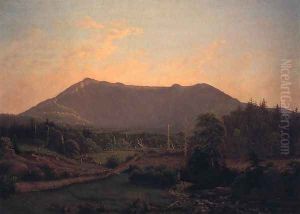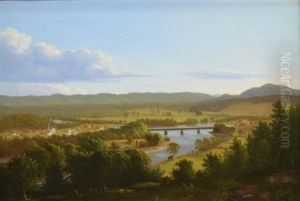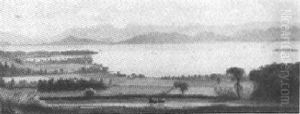Charles Louis Heyde Paintings
Charles Louis Heyde was a notable American landscape painter, born in 1822 in Charleston, South Carolina. He is particularly celebrated for his picturesque landscapes of Vermont and the Hudson River Valley, capturing the serene beauty of these regions with a distinctive style that emphasized the sublime aspects of nature. Heyde's artistic journey began in his youth, but his life was not solely dedicated to art from the start. His early years and education remain somewhat obscured in historical records, which is common for many artists of his era. However, it is known that he eventually ventured northward, where he found his lifelong inspiration in the landscapes of New England.
After settling in Vermont in the 1850s, Heyde became deeply intertwined with the local scenery, especially Lake Champlain and the surrounding areas. His paintings often feature detailed and idyllic representations of the Vermont landscape, characterized by their meticulous attention to the changing seasons, light, and atmospheric conditions. Despite facing financial difficulties and relative obscurity during his lifetime, Heyde's commitment to his craft never wavered. He was a prolific artist, leaving behind a large body of work that has since gained recognition for its contribution to the American landscape painting tradition.
Heyde's personal life was marked by struggles, including financial instability and health issues. He was married to Hattie Freeman, and their relationship, though supportive in terms of Hattie's encouragement of his art, was strained by Heyde's continuous struggles with alcoholism and the couple's financial hardships. Significantly, Heyde was the brother-in-law of the famous poet Walt Whitman, which brought a certain level of literary connection to his life, though it did not substantially impact his financial or artistic success during his lifetime.
Charles Louis Heyde passed away in 1892 in Burlington, Vermont, where he had spent much of his adult life. Though he was not widely recognized in the art world at the time of his death, subsequent generations have come to appreciate his work for its beauty and historical value. Today, Heyde is acknowledged as an important figure in the 19th-century American landscape painting movement, with his works held in various collections and museums, serving as a testament to his enduring legacy as an artist who captured the American landscape with both affection and detail.

!['curls Head, Mallets [sic] Bay', Vermont](https://www.niceartgallery.com/imgs/3867625/s/charles-louis-heyde-curls-head-mallets-sic-bay-vermont-77387a7d.jpg)

